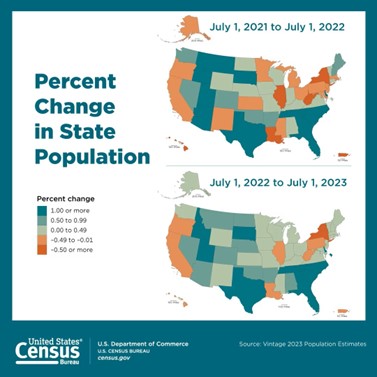Blog Post
Insight: New 2023 Census Bureau Estimates- National, Regional, and State Total Population and Components of Population Change
By Emily Harris
This week, the Census Bureau released its first set of population estimates for the 2023 vintage: national and state resident population and components of change. This release provides a snapshot of the total population for all 50 states on July 1, 2023.
Utah Results
According to Census Bureau population estimates, Utah grew from 3,381,236 in 2022 to 3,417,734 in 2023, growing by 36,498 or 1.1%. Utah ranked 10th nationally for absolute population growth and 9th for percentage growth. This is the lowest Census Bureau percent population growth for Utah since the Great Recession. These estimates show that Utah’s main source of population growth was natural increase at 24,796, while net migration of 11,623 was lower than 2022’s net migration of 19,265.
Utah in the national rankings:


National Results
The Census Bureau estimates show a return to pre-pandemic levels as deaths sharply declined and international migration returned. These two demographic shifts resulted in the U.S.’s largest population gain since 2018, though still relatively low.
Regional Results
Three of the four Census regions experienced population increases in 2023. The Southern region (population of 130,125,290) boasted the most growth of all regions (1.1%) and was dominated by net in-migration of approximately 1,200,000 new residents. The Western and Midwestern regions both grew by .2%, but grew from different components of change. The Western region experienced net out-migration but experienced strong natural increase, while the Midwestern region had lower natural increase but higher net in-migration. The Northeastern region declined from net out-migration while still experiencing natural increase.
How does this compare to the Utah Population Committee (UPC) estimates for 2023?
The UPC estimates indicate Utah experienced higher growth of 55,989 or 1.6%, putting the July 1, 2023 population at 3,456,482. This is a difference of 38,748 or 1.1% compared to the Census Bureau’s estimate and is a result of the Census Bureau’s much lower net migration estimate. A difference in methodologies causes these differences in the estimates.
While the Census Bureau estimates are the best resource for state comparisons, we are confident in the UPC estimates as a reliable resource for Utah-focused purposes. These estimates are closely vetted by local data experts and allow attention to unique circumstances we might experience in Utah.
Additional notes on Census Bureau estimates
This release kicks off the population estimates season, cascading into county estimates in March, city estimates in May, and ending with demographic characteristics such as age, sex, and race and ethnicity in June.
Stay tuned as we continue to monitor and analyze new Census Bureau estimates releases!
Emily Harris is a senior demographer at the Kem C. Gardner Policy Institute.
